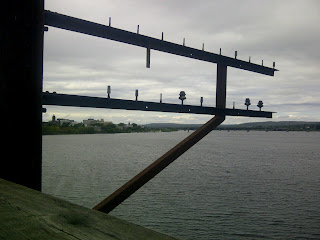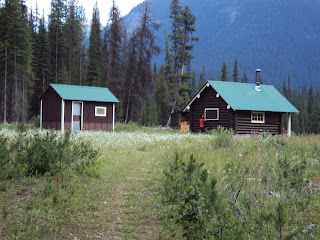Gazette home page: http://www.alpineclubofcanada.ca/gazette/index.html
And here is the text:
Cochamó is how we spell Paradise
By Inga
Petri
We had finally arrived at the beginning.
I remember in my bones what it felt like to hike to, be in and leave Cochamó Valley, a northern Patagonian gem we discovered during semana santa, the holy week between Christmas and New Year’s.
We learned about Cochamó from a guide we met while trekking in Torres del Paine National Park. His words: “If you want something different, go to Cochamó. The trekking there is an experience unlike any other.” We learned that the only way in was a 5-hour hike; we decided to go.
We had been trekking in Peru and Bolivia during October and November and were spending December in Chilean Patagonia to enjoy the southern hemisphere’s endless days of summer. To get to Cochamó we could simply have flown from Punta Arenas to Puerto Montt but instead opted for the slow way: We embarked on the Navimag ferry in Puerto Natales. This 4 nights/ 3 days excursion through Patagonian fjords and open Pacific is used by two kinds of people: backpackers and truckers ferrying livestock and other goods. We spent time resting, admiring glaciers, dolphins and ship wrecks and meeting backpackers undertaking all manner of journeys. It was worth the time.
We arrived in Puerto Montt on Christmas Eve just in time to stock up on food and wine before stores closed for the holiday. We got tickets for the local bus ($4 each) for the two-hour ride to Cochamó. Our bus driver’s and his assistant’s unbridled enthusiasm for our destination startled us. We had intended to find a local ride from the village of Cochamó to the trailhead. Instead our excited bus driver let us off several kilometres past the village at the beginning of the 6 km gravel road leading to the trailhead.
We got off the bus, which left in a plume of dust as it headed down the dirt road. This was it: an unremarkable, empty intersection in Northern Patagonia’s Lake District. We had a snack, drank some water and shouldered our 45-pound backpacks.
There was no traffic. We passed a few farm houses and beekeepers. The last house on the road was said to serve drink, food and have space for camping. We said Hola to the owner. Due to the holiday he was out of supplies but invited us to stay when we would return.
We hiked on. Now the trail began; part of the storied Gaucho Trail connecting Argentina’s Lake District across the Andes with the Pacific Ocean. It had been raining hard, so we encountered copious amounts of mud as we hiked deeper into the valley. The trenches, forged through cattle drives and some as deep as two metres, were filled with puddles of uncertain depth. River crossings featured logs with few man-made supports, if any. We were glad to wear gaiters and waterproof boots despite the summer’s heat.
As we progressed from sea level near the Reloncaví estuary, we hiked through dense native forests, with glimpses of the crystal Cochamó River. Huge bamboo shoots appeared as we proceeded through Patagonian rain forest. Suddenly, the vista opened toward La Junta, our destination, with its pampas grassland surrounded by sharply rising 1,000 m granite domes. We easily found camp with its central cook house, outhouses and an information board nearby. There were a handful of tents and roaming horses. We settled in ($4 pp/d).
Following the path to the rustic cable car crossing − powered by human effort alone, so it’s best to have a friend along especially because the return is slightly uphill − we introduced ourselves at Refugio Cochamó. Later, we met the other campers while preparing dinner. All were here to climb, hike or toboggan the waterfall slides. Without exception, they referred to Cochamó as paradise. Getting here takes effort; an effort worth making.
The next day, we hiked to the base of Trinidad Mountain through thick, steep rainforest. It was immediately clear that the trails had been cut as approach trails to big wall climbs. They are demanding, and at times spectacularly exposed. Fixed ropes are installed where necessary to ensure upward movement, not to provide comfort.
The following day, Arco Iris (1,668 m) was our objective. This trail was cut by machete as Cochamó’s first valley-to-peak trail in 2007. Native forest gives way to massive 3,000-year-old Alerce trees, rain forest and then the first magnificent views across the valley. The most unusual trail feature might well be the fixed rope leading steeply up a granite slab beneath massive tree roots. Or maybe it is the wild granite ridge above tree line. From the snow-capped summit hikers enjoy awesome views over the valley and surrounding mountains, the Reloncaví estuary and distant volcanoes.
The next afternoon we hiked out so we could make our way to the famed coastal city of Valparaíso for New Year’s celebrations. We had planned to camp at the trailhead and then catch the bus at our drop-off the next afternoon. When we arrived two locals told us that the owner had been taken to hospital. Reluctantly, we hiked out to the main dirt road, 6 km, and then started toward the village. A couple of kilometres in, a lovely woman in a pick-up truck offered us a ride. We gladly jumped on the back in our seventh hour of hiking. She didn’t want payment and instead dropped us off at her brother Ruben’s private camp ($5 each).
It had gorgeous views of the glaciated Yate Volcano across the estuary. We had the meadow to ourselves and enjoyed a perfect camp stove dinner while the sun set across the Pacific and dabbed the clouds overhead in shades of red. This would be the last camping meal of our three months South American trek. We left our fuel with Ruben.



















































